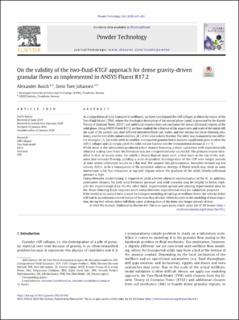| dc.description.abstract | ( Engelsk )
As a subproblem of solid transport in wellbores, we have investigated the cliff collapse problem by means of the Two-Fluid-Model (TFM), where the rheological description of the second phase (sand) is governed by the Kinetic Theory of Granular Flows (KTGF) and additional closures from soil mechanics for dense (frictional) regions of the solid phase. Using ANSYS Fluent R17.2, we have studied the influence of the aspect ratio and scale of the initial cliff, the scale of the particle size, four different interstitial fluids (air, water, and two viscous but shear-thinning solutions), and the role of the initial condition (IC) of the solid volume fraction. The latter was evaluated by two different strategies: (1) Let solids settle to establish a compacted granular bed in dynamic equilibrium prior to allow the cliff to collapse and (2) simply patch the solid volume fraction into the computational domain at t = 0. While most of the simulations produced a final deposit featuring a slope, validation with experimentally obtained scaling laws from the literature was not comprehensively successful. The primary reason identified is that, at steady-state, for which a sloped deposit must exist, a thin layer at the top of the sediment bed remains flowing, yielding a scale-dependent disintegration of the cliff over longer periods of time which ultimately results in a flat bed. We suspect this phenomenon, hereafter termed top bed velocity defect, to be a consequence of the numerical solutions strategy of Fluent which may result in some momentum solid flux imbalance at top-bed regions where the gradient of the solids kinetic/collisional pressure is high. Comprehensive model tuning is required to yield a better physical representation of the IC. In addition, alternative closures for both solid frictional pressure and solid viscosity may be helpful to better replicate the experimental data. On the other hand, experimental spread and missing experimental data for the shear-thinning fluids requires more comprehensive experimental data for validation purposes. If the model in its current form is used for transport modeling of cuttings in wellbore flows, the velocity defect will lead to an unknown overestimation of the mass flux of solids. When it comes to the modeling of dune migration, the top bed velocity defect will likely cause disintegration of the dune over longer periods of time. | en_US |

